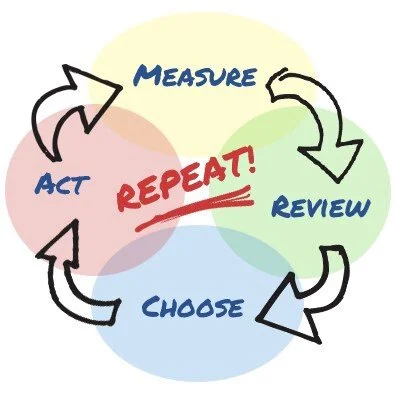Systems Thinking — The Essential Mental Models Needed for Growth
Understanding Bottlenecks, Leverage, and Feedback Loops
In the previous chapter, I showed you how to frame your goals. It’s now time to put them into practice; goals do not just go and achieve themselves. If you want to actually make regular progress, you will need a system.
In this series, you will learn how to create the systems which will make fundamental upgrades to your source code. You will be able to overwrite your default behaviors, making changes you can sustain for as long as your goals are aligned; for a lifetime if deemed necessary.
I will introduce the three key mental models from systems thinking which form the core of my approach towards growth: bottlenecks, leverage, and feedback loops. Systems thinking is my multi-tool which makes the analysis and improvement of all parts of my life possible — the paradigm that shifts all my other paradigms.
Having an exciting goal can propel you forward, but only for a temporary sprint. Perhaps you have a friend who wanted to “get in shape” and started running regularly after signing up for a marathon. I would be willing to bet that this friend stopped running as soon as the race was completed. This is an example of a goal acting as an incentive that, once achieved or removed, causes our underlying motivation to disappear as well.
Remember this: systems and processes will always surpass motivation.
Let us start with a definition. A system is a group of interacting parts. These parts form a unified whole which is directed towards a specific goal. This whole (the system) has widely differing properties which are greater than the sum of its component parts. Systems display emergence, which means a small change to one part can have an outsized and unpredictable effect upon the whole system.
Conway’s Game of Life on a Trefoil Knot
You will soon realize that everything is a system.
The universe starts to make much more sense when you realize everything is but a series of intersecting, interconnected, and interacting systems.
Whether you realize it or not, you are an essential participant in many systems. Your organizations and communities? Systems. Every day you interact with countless systems such as cars, computers, and even the stock market.
You (yes you!) are an incomprehensibly complex biological system comprising many smaller systems, which are in turn comprised of smaller and smaller systems all the way down to the cellular, molecular, and quantum levels.
It is systems all the way down.
This is what makes being a human, an adaptive living system, so interesting. We are continuously evolving. With our unique biological ability of abstract thinking, we can rise above the systems in which we find ourselves rather than being confined to them. Rather than simply following the instructions our blind watchmaker hard-coded into us via DNA (i.e. go forth and multiply and then make room for the next generation), we can play any number of infinite games available by writing our own rulebooks.
We always have the capacity to rewrite the goals we align ourselves (and our systems) towards. One level of abstraction higher, we can change the system we use to generate and select between potential goals, as discussed in our post on goal setting. At the highest level, we can even rewrite our utility functions: our mental models, belief structures, deeply-held priceless values, and assumptions about objective reality.
• • •
Without further ado, let’s introduce the essential mental models for systems thinking:
The first mental model comes from the world of manufacturing systems and is known as the Theory of Constraints. Every system is limited by various constraints but will, by definition, have one constraint tighter than all the others. As a chain will always have a weakest link, there will always be a weakest constraint within a system. We call this constraint the bottleneck, the point of greatest congestion causing delay within a system.
The implication of the Theory of Constraints, as Eliyahu Goldratt describes in The Goal, is that the performance of any system is fundamentally limited by the output of the bottleneck. Thus, no change to the system will result in overall improvement unless that change addresses the bottleneck.
Taken from Tiago Forte’s excellent series on the Theory of Constraints, linked above.
The Theory of Constraints tells us that the majority of our self-improvement projects are wasted efforts because we fail to identify and address our own bottlenecks. We find ourselves running on a hamster wheel, making change after change but not really getting anywhere. It is important to note that we don’t need more effort, just effort applied more effectively.
Removing a particular bottleneck is never an objective in itself, but simply how we keep the game going. It is the only way to ensure growth over time. We cannot identify the next set of challenges while the current bottleneck is in place. Once the bottleneck has been removed, our system (aka our lives!) will experience a phase transition as well, shifting everything else in its wake.
Focus on your bottleneck first and ignore everything else in the meantime.
Leverage is the ability to influence a system in the way which returns maximum effect per unit of effort. With limited time, energy, and focus to invest, we can maximize our ROI from these resources by applying them with leverage. Treating time, energy, and focus as interchangeable financial currencies, we convert them wherever we find the best exchange rate.
Amateurs use willpower for generating motivation. Professionals use willpower for strengthening their systems of execution at the point of greatest leverage, building automatons rather than trying to become one.
Most of you will be familiar with the Pareto Principle or the 80/20 Rule. The principle famously states that most phenomena fall on a power law distribution (i.e. one quantity varies as a power of the other).
You can see here that, generally, 80% of the results can be achieved with 20% of the effort… this is not groundbreaking. The takeaway here is hidden in the vertical line. If you move further down the curve you will find that 50% of the results can be achieved with just 1% of the effort.
That line pointing straight up? That’s where you want to be.
What is the implication here? Make sure you understand what level of expertise or skill your goals truly require before you hit diminishing marginal returns.
Given you can become competent (top 20%) in 5 overlapping skills or above average (top 50%) in 100 overlapping skills in the time it will take you to become an expert (top 1%) in just one skill, choose your areas of mastery carefully.
Leverage tells us that there will always be opportunities to make a small change in our lives which will have an outsized effect. Before you build an elaborate apple picker from scratch, make sure to check for low hanging fruit.
In Thinking in Systems, Donella Meadows details the points of greatest leverage within a system:
Change the rules. By changing the rules, we can define what actions are possible within the system. This will be our choice of daily habits, the focus of our next three chapters, and the building block for our systems.
Build in self-organization. We can design our systems in such a way that they will naturally improve over time by creating forcing functions. A few examples of forcing functions include precommitment, installing artificial checkpoints, and setting up intentional constraints in our environment.
Improve information flow. We can take more objective, accurate, and frequent measurements as well as reflecting regularly to track our progress. We use the information gained from measurement to improve our systems by building in feedback loops.
Feedback is defined as the sending and returning of information to a system. The primary function of feedback is to let a system know how it is doing relative to a desired state.
We refer to feedback as a loop because the relationship between the measurement and the thing being measured is circular rather than linear. Taking a measurement causes a system response to bring the measured quantity closer to the goal, which in turn changes the measurement. The consequences of taking a measurement “feed back” to affect the overall system, creating a loop.
There are two types of feedback loops. The most common is a balancing feedback loop which attempts to maintain a stable status quo or equilibrium. An example of this type is a thermostat, which aims to maintain a goal temperature in the room.
Homeostasis is our body’s balancing feedback loop. Without homeostasis, we would not survive. This survival mechanism comes at a cost as homeostasis is also our body’s resistance to change, our prime opponent in building new patterns of behavior.
The second type is a reinforcing feedback loop which brings growth or decay to a system. With a reinforcing feedback loop in place, a change in one direction results in even more change in that direction. A reinforcing feedback loop will result in a virtuous (+) or vicious (-) cycle which, left unchecked, will send a system’s value to either infinity or zero respectively. Viral marketing is an example of a virtuous cycle while global warming is an example of a vicious cycle.
Stampedes are an example of a reinforcing feedback loop.
Feedback Loops: Installation
We install balancing feedback loops to keep our desired behaviors consistent and reduce the damage taken when we (inevitably) fall off track. I call these “firebreaks” — pre-planned checkpoints where we can call in for reinforcements or step back to evaluate a new plan of attack.
Conversely, for those of us with grand ambitions, it is critical that we maintain a constant vigilance of the balancing feedback loops all around us. Counterbalancing forces in our bodies, environments, relationships, and culture all attract us towards an undesired equilibrium. We can overcome these status quo plateaus through a strategic “heavy lift”, where we can establish new defaults, baselines, and social norms.
We install reinforcing feedback loops to optimize our processes and set the bar for ourselves progressively higher over time. Long-term growth comes from incremental daily improvements upon the previous day’s improvements. These small efforts accumulate and build upon themselves like compound interest.
Do this.
Aim to minimize the delay between measurement and system improvement as much as possible. Think of yourself as a product in perpetual beta: moving fast and breaking things. Whomever iterates the fastest, wins.
The power of iteration is why I emphasize establishing a “daily system”. Testing, measuring, and installing just one small improvement upon your system daily creates the tight feedback loop which makes it seem like everyone else is standing still.
We live our lives within a very narrow band of possibility.
Conclusion
These three mental models — bottlenecks, leverage, and feedback loops — combine to form our multi-tool for growth.
We use measurement and self-awareness to identify any obstacles constraining us, and conduct small behavioral experiments to validate our assumptions. If one small change to an obstacle changes everything else, we have identified the bottleneck. We redirect all the extra time, focus, and energy we have towards this bottleneck, sequentially trying the highest leverage interventions available to us.
We always focus our attention on the bottleneck first until it becomes apparent that the bottleneck is no longer what most constrains us. We then begin the process anew and start with identifying our new bottleneck.
The momentum built from this recurring cycle will actually do most of our work for us. With each iteration, we push our systems (and ourselves) to the next level of emergence. Our future bottlenecks will be less constraining and our system will have approached ever closer to an optimal state.
This feedback loop is the basis of this whole series in a nutshell:
Find your bottleneck
Experiment (try things!) to remove your bottleneck
Repeat.
• • •
For now, hold these ideas in mind and keep your eyes open for examples in your daily life. Once you have grokked systems, you will start to see them everywhere.
You will undoubtedly come across many ideas for improvement unrelated to your current bottleneck. My hope is that you will resist the temptation of the traditional buffet approach, trying a “productivity hack” here and a ShinyNewTool there.
If you take one thing away from this, I hope it is the understanding that most self-improvement advice should be ignored . . . at least for now. Once you find the one thing that is most limiting you right now — focus on that and don’t worry about anything else.
Special thanks to Marianna Phillips for editing this post.











